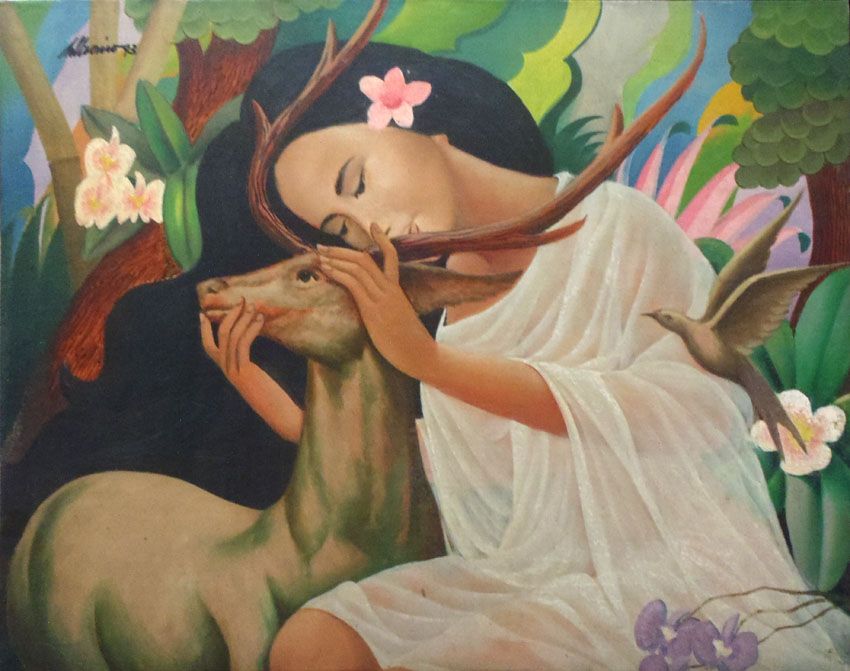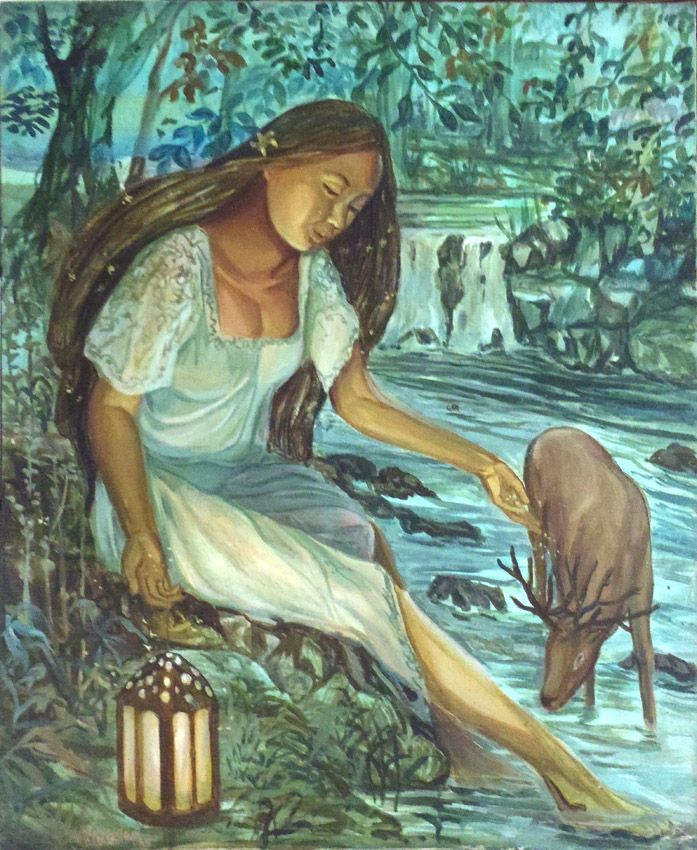Tagalog pantheon
"Among their many idols there was one called. [B]Badhala, whom they especially worshiped. The title seems to signify “all powerful,” or “maker of all things.”[/B] [B]They also worshiped the sun, which, on account of its beauty, is almost universally respected and honored by heathens. They worshiped, too, the moon, especially when it was new, at which time they held great rejoicings, adoring it and bidding it welcome[/B]. Some of them also adored the stars, although they did not know them by their names, as the Spaniards and other nations know the planets—with the one exception of [B]the morning star, which they called Tala[/B]. They knew, too, the “seven little goats” [the Pleiades]—as we call them—and, consequently, the change of seasons, which they call Mapolon; and Balatic, which is our Greater Bear. They possessed many idols called lic-ha, which were images with different shapes; and at times they worshiped any little trifle, in which they adored, as did the Romans, some particular dead man who was brave in war and endowed with special faculties, to whom they commended themselves for protection in their tribulations. They had another idol called Dian masalanta, who was the patron of lovers and of generation. The idols called Lacapati and Idianale were the patrons of the cultivated lands and of husbandry. They paid reverence to water-lizards called by them buaya, or crocodiles, from fear of being harmed by them. They were even in the habit of offering these animals a portion of what they carried in their boats, by throwing it into the water, or placing it upon the bank.”
Omen birds
“They were, moreover, very liable to find auguries in things they witnessed. For example, if they left their house and met on the way a serpent or rat, or a bird called Tigmamanuguin which was singing in the tree, or if they chanced upon anyone who sneezed, they returned at once to their house, considering the incident as an augury that some evil might befall them if they should continue their journey—especially when the above-mentioned bird sang. This song had two different forms: in the one case it was considered as an evil omen; in the other, as a good omen, and then they continued their journey. They also practiced divination, to see whether weapons, such as a dagger or knife, were to be useful and lucky for their possessor whenever occasion should offer."
[IMG]  [/IMG]
[/IMG]
Babaylan by R. Aguilar (obviously depicting Visayan shaman, but the catalononan of the Tagalogs and Kapampangan/Luzon functioned the same way)
PS The root word used for babaylan, 'bay' is ancient cognate for 'females'. Babae (Tagalog for woman), bayi (maiden in some Lumad languages), bay (the honorific used in Mindanao for noble women ie 'lady')
[IMG]  ?w=500&h=536[/IMG]
?w=500&h=536[/IMG]
Part 1 of Botong Francisco's "Progress of Medicine in the Philippines" mural
Shamans/priests/priestesses
“Their manner of offering sacrifice was to proclaim a feast, and offer to the devil what they had to eat. This was done in front of the idol, which they anoint with fragrant perfumes, such as musk and civet, or gum of the storax-tree and other odoriferous woods, and praise it in poetic songs sung by the officiating priest, male or female, who is called catolonan. The participants made responses to the song, beseeching the idol to favor them with those things of which they were in need, and generally, by offering repeated healths, they all became intoxicated. In some of their idolatries they were accustomed to place a good piece of cloth, doubled, over the idol, and over the cloth a chain or large, gold ring, thus worshiping the devil without having sight of him. The devil was sometimes liable to enter into the body of the catolonan, and, assuming her shape and appearance, filled her with so great arrogance—he being the cause of it—that she seemed to shoot flames from her eyes; her hair stood on end, a fearful sight to those beholding, Page 180and she uttered words of arrogance and superiority. In some districts, especially in the mountains, when in those idolatries the devil incarnated himself and took on the form of his minister, the latter had to be tied to a tree by his companions, to prevent the devil in his infernal fury from destroying him. This, however, happened but rarely. The objects of sacrifice were goats, fowls, and swine, which were flayed, decapitated, and laid before the idol. They performed another ceremony by cooking a jar of rice until the water was evaporated, after which they broke the jar, and the rice was left as an intact mass which was set before the idol; and all about it, at intervals, were placed a few buyos—which is a small fruit3 wrapped in a leaf with some lime, a food generally eaten in these regions—as well as fried food and fruits. All the above-mentioned articles were eaten by the guests at the feast; the heads [of the animals], after being “offered,” as they expressed it, were cooked and eaten also.
The reasons for offering this sacrifice and adoration were, in addition to whatever personal matters there might be, the recovery of a sick person, the prosperous voyage of those embarking on the sea, a good harvest in the sowed lands, a propitious result in wars, a successful delivery in childbirth, and a happy outcome in married life. If this took place among people of rank, the festivities lasted thirty days.
The distinctions made among the priests of the devil were as follows: The first, called catolonan, as above stated, was either a man or a woman. This office was an honorable one among the natives, and was held ordinarily by people of rank, this rule being general in all the islands."
Witches/mangkukulam (one who curses/hex)/healers
“The second they called mangagauay, or witches, who deceived by pretending to heal the sick. These priests even induced maladies by their charms, which in proportion to the strength and efficacy of the witchcraft, are capable of causing death. In this way, if they wished to kill at once they did so; or they could prolong life for a year by binding to the waist a live serpent, which was believed to be the devil, or at least his substance. This office was general throughout the land. The third they called manyisalat, which is the same as magagauay. These priests had the power of applying such remedies to lovers that they would abandon and despise their own wives, and in fact could prevent them from having intercourse with the latter. If the woman, constrained by these means, were abandoned, it would bring sickness upon her; and on account of the desertion she would discharge blood and matter. This office was also general throughout the land.
The fourth was called mancocolam, whose duty it was to emit fire from himself at night, once or oftener Page 182each month. This fire could not be extinguished; nor could it be thus emitted except as the priest wallowed in the ordure and filth which falls from the houses; and he who lived in the house where the priest was wallowing in order to emit this fire from himself, fell ill and died. This office was general.
The fifth was called hocloban, which is another kind of witch, of greater efficacy than the mangagauay. Without the use of medicine, and by simply saluting or raising the hand, they killed whom they chose. But if they desired to heal those whom they had made ill by their charms, they did so by using other charms. Moreover, if they wished to destroy the house of some Indian hostile to them, they were able to do so without instruments. This was in Catanduanes, an island off the upper part of Luzon.
The sixth was called silagan, whose office it was, if they saw anyone clothed in white, to tear out his liver and eat it, thus causing his death. This, like the preceding, was in the island of Catanduanes. Let no one, moreover, consider this a fable; because, in Calavan, they tore out in this way through the anus all the intestines of a Spanish notary, who was buried in Calilaya by father Fray Juan de Mérida."
Manananggal ('one who takes off..." ie 'one who decapitates')
The seventh was called magtatangal, and his purpose was to show himself at night to many persons, without his head or entrails. In such wise the devil walked about and carried, or pretended to carry, his head to different places; and, in the morning, returned it to his body—remaining, as before, alive. This seems to me to be a fable, although the natives affirm that they have seen it, because the devil probably caused them so to believe. This occurred in Catanduanes.
Aswang
The eighth they called osuang, which is equivalent to “sorcerer;” they say that they have seen him fly, and that he murdered men and ate their flesh. [B]This was among the Visayas Islands; among the Tagalos these did not exist[/B].
Gayuma (love potion)
The ninth was another class of witches called mangagayoma. They made charms for lovers out of herbs, stones, and wood, which would infuse the heart with love. Thus did they deceive the people, although sometimes, through the intervention of the devil, they gained their ends.
The tenth was known as sonat, which is equivalent to “preacher.” It was his office to help one to die, at which time he predicted the salvation or condemnation of the soul. It was not lawful for the functions of this office to be fulfilled by others than people of high standing, on account of the esteem in which it was held. This office was general throughout the islands.
The eleventh, pangatahojan, was a soothsayer, and predicted the future. This office was general in all the islands.
The term of a homosexual/transgender holding a religious role is not uncommon. This is of the Tagalogs (possibly shared with Kapampangans). Chirino mentions an effeminate also being selected at times as shamans amongst the Visayans. Combes mentioned a ‘strange’ tradition amongst Subanons of northern Mindanao wherein a man will dress up as a woman and live with them in order to protect their virtue. They were expected to abstain from from sex and keep away from plain view. (Funniest part: Combes thought they’d make great priests. –lmao)
The twelfth, bayoguin, signified a “cotquean,” a man whose nature inclined toward that of a woman.
De Plasencia (“Relacion de las…”/Customs of the Tagalogs)
 [/IMG]
[/IMG] ?w=500&h=536[/IMG]
?w=500&h=536[/IMG]



